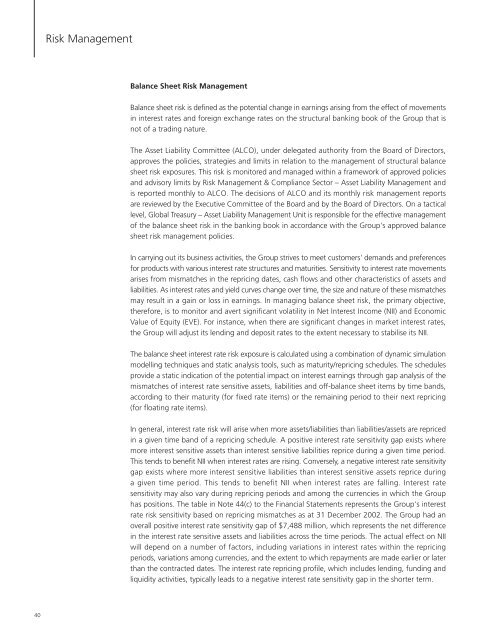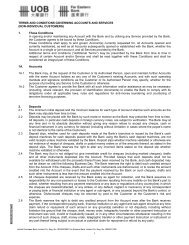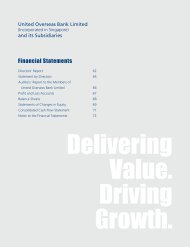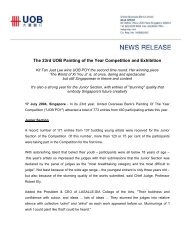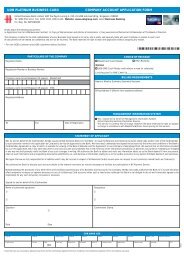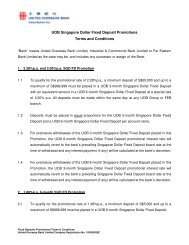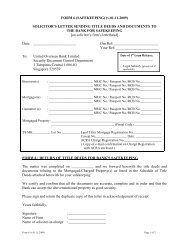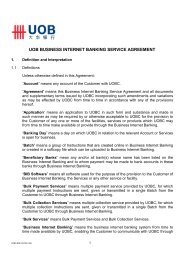UOB Annual Report 2002 - United Overseas Bank
UOB Annual Report 2002 - United Overseas Bank
UOB Annual Report 2002 - United Overseas Bank
Create successful ePaper yourself
Turn your PDF publications into a flip-book with our unique Google optimized e-Paper software.
Risk Management<br />
Balance Sheet Risk Management<br />
Balance sheet risk is defined as the potential change in earnings arising from the effect of movements<br />
in interest rates and foreign exchange rates on the structural banking book of the Group that is<br />
not of a trading nature.<br />
The Asset Liability Committee (ALCO), under delegated authority from the Board of Directors,<br />
approves the policies, strategies and limits in relation to the management of structural balance<br />
sheet risk exposures. This risk is monitored and managed within a framework of approved policies<br />
and advisory limits by Risk Management & Compliance Sector – Asset Liability Management and<br />
is reported monthly to ALCO. The decisions of ALCO and its monthly risk management reports<br />
are reviewed by the Executive Committee of the Board and by the Board of Directors. On a tactical<br />
level, Global Treasury – Asset Liability Management Unit is responsible for the effective management<br />
of the balance sheet risk in the banking book in accordance with the Group's approved balance<br />
sheet risk management policies.<br />
In carrying out its business activities, the Group strives to meet customers' demands and preferences<br />
for products with various interest rate structures and maturities. Sensitivity to interest rate movements<br />
arises from mismatches in the repricing dates, cash flows and other characteristics of assets and<br />
liabilities. As interest rates and yield curves change over time, the size and nature of these mismatches<br />
may result in a gain or loss in earnings. In managing balance sheet risk, the primary objective,<br />
therefore, is to monitor and avert significant volatility in Net Interest Income (NII) and Economic<br />
Value of Equity (EVE). For instance, when there are significant changes in market interest rates,<br />
the Group will adjust its lending and deposit rates to the extent necessary to stabilise its NII.<br />
The balance sheet interest rate risk exposure is calculated using a combination of dynamic simulation<br />
modelling techniques and static analysis tools, such as maturity/repricing schedules. The schedules<br />
provide a static indication of the potential impact on interest earnings through gap analysis of the<br />
mismatches of interest rate sensitive assets, liabilities and off-balance sheet items by time bands,<br />
according to their maturity (for fixed rate items) or the remaining period to their next repricing<br />
(for floating rate items).<br />
In general, interest rate risk will arise when more assets/liabilities than liabilities/assets are repriced<br />
in a given time band of a repricing schedule. A positive interest rate sensitivity gap exists where<br />
more interest sensitive assets than interest sensitive liabilities reprice during a given time period.<br />
This tends to benefit NII when interest rates are rising. Conversely, a negative interest rate sensitivity<br />
gap exists where more interest sensitive liabilities than interest sensitive assets reprice during<br />
a given time period. This tends to benefit NII when interest rates are falling. Interest rate<br />
sensitivity may also vary during repricing periods and among the currencies in which the Group<br />
has positions. The table in Note 44(c) to the Financial Statements represents the Group's interest<br />
rate risk sensitivity based on repricing mismatches as at 31 December <strong>2002</strong>. The Group had an<br />
overall positive interest rate sensitivity gap of $7,488 million, which represents the net difference<br />
in the interest rate sensitive assets and liabilities across the time periods. The actual effect on NII<br />
will depend on a number of factors, including variations in interest rates within the repricing<br />
periods, variations among currencies, and the extent to which repayments are made earlier or later<br />
than the contracted dates. The interest rate repricing profile, which includes lending, funding and<br />
liquidity activities, typically leads to a negative interest rate sensitivity gap in the shorter term.<br />
40


